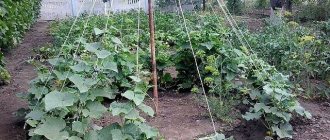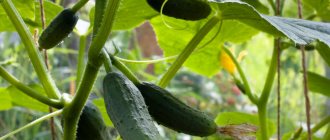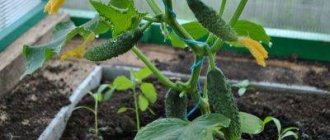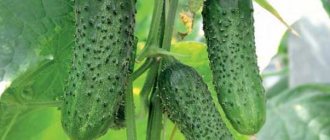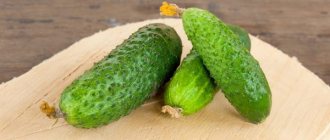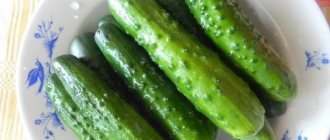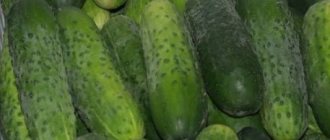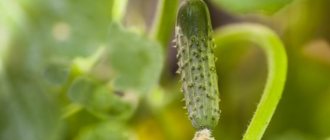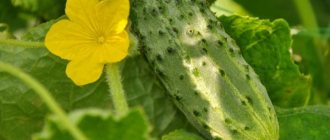Vyuga F1 is a popular hybrid variety among gardeners in regions with a cool, unstable climate. Cucumber is perfectly adapted to cold weather and is not afraid of short-term frosts. Important bonuses include high productivity, excellent product and taste characteristics. The cultivar has good health and is rarely affected by cucumber infection.
| Landing location | Ripening time | Mode of application | Fruit length | Group | Fruit smoothness | Pollination method |
| Universal | Early ripening (35-45 days) | Universal | Short (gherkins) - less than 10 cm | Hybrid | Highly lumpy | Parthenocarpic |
Description and characteristics of the variety
Vyuga F1 from Biotechnika was bred by crossing 2 super early varieties. The originator is a St. Petersburg agricultural company. The hybrid turned out to be cold-resistant and hardy.
The harvest begins very early - 37-40 days from germination.
The hybrid is parthenocarpic and does not require the participation of insects for pollination. The bushes are moderately weaving, the central shoot is unlimited in growth.
Hybrid characteristics:
- indeterminate growth;
- short side branches;
- medium-sized bushes;
- in 1 node there are from 3 to 5 cucumbers.
Abundant flowering occurs in the early stages. Up to 15 gherkins are collected from 1 bush at a time. The fruits are highly marketable and beautiful, suitable for universal use. They make excellent salads and appetizers, slices and assorted dishes. When preserved or pickled, cucumbers have a strong, unforgettable taste.
Properties of gherkins:
- length 6-8 cm;
- weight 60-70 g;
- the skin is bright green;
- the tubercles are large;
- pubescence is white;
- The pulp is tender, juicy, crispy.
The taste is sweetish, without bitterness. Its beautiful appearance and taste are preserved during salting and canning.
Diseases and pests
Hybrid Vyuga f1 is famous for its increased resistance to powdery mildew, spotting and downy mildew. If you adhere to all the rules of agricultural technology and take into account planting recommendations, the variety will not get sick. However, improper care leads to infection of cucumber bushes with root rot, cladosporiosis and wet rot.
Root rot
Root rot is a pathology expressed in patches. The first symptoms of the disease are wilting of the tops. Already at this moment, experts recommend inspecting the root system of the variety (remove some soil from the roots of the bush).
During infection, thinning of the stem and the formation of small cracks are also observed. Also, the roots begin to darken, soften, and the lower tops acquire a yellow color. Chemicals are used to treat the soil:
- "Alirin-B";
- "Previkur";
- "Gamair".
Cladosporiosis
The disease cladosporiosis is a fungus that attacks cucumbers, forming small ulcers on them. When the Vyuga hybrid becomes diseased, significant losses of gherkins are observed. The infection spreads as a result of excessive watering and severe waterlogging of the beds, sudden changes in temperature and strong winds.
If cladosporiosis is observed on Vyuga f1 bushes, it is necessary to stop watering procedures and increase the temperature (if the crop is grown in a greenhouse). The planting is also treated with the drug “Oxychom”.
Wet rot
Infection with wet rot has been observed from the moment of planting damaged Vyuga f1 seeds. The pathology develops along with the bushes, but appears only during the fruiting period.
With wet rot, plants become covered with small green spots, which later turn into necrosis. Darkening of the stem is also observed, leading to the death of the cucumber plant. It is recommended to treat beds with wet rot with the following preparations:
- "Home";
- "Gamair";
- "Previkur".
Growing and care
Cultivation is carried out in a standard way. Bushes require:
- watering is regular and moderate;
- weeding and loosening;
- mulching.
Since the variety is grown in the northern regions, the seeds are sown for seedlings from mid to late April. Prepare a fertile, well-drained substrate, use a universal mixture or mix the following components:
- 2 parts of turf;
- 1 part compost;
- 1 part humus;
- 1 part peat;
- 1 part sand.
Additionally, superphosphate and potassium salts are added to increase nutritional value. The seeds are planted to a depth of 2 cm. The earth is lightly compacted. The boxes are kept under film until germination.
They are transplanted into a greenhouse if there are 3-4 leaves on the seedlings, the timing is from the beginning of May. Bushes are planted in open beds when the temperature of the beds rises to 14 degrees.
Landing Features
The hybrid variety Vyuga f1 is cultivated in a variety of climatic conditions: in greenhouses and covered beds. Cucumbers are also suitable for growing in two ways: seedlings and sowing. It is recommended to plant the variety's seeds for seedlings from April 15 to April 25. If the variety is grown by seeding, the seeds are planted from May 25 to June 10. It is also important to choose the right site for growing the variety and prepare it.
Site preparation
Before you start preparing beds for growing the Vyuga variety, you need to choose it correctly. Sunny beds protected from strong gusts of wind are suitable for growing cucumbers.
It is also important to pay attention to the acidity and fertility of the soil. In the fall, the future beds are cleared of tops and dug up along with manure to a depth of 10 cm. In the spring, it is recommended to loosen the soil so that it warms up quickly and you can start planting.
Vegetable growers note that to cultivate the Vyuga crop in open soil, it is advisable to cover the beds with a thick film after loosening. This procedure is necessary to quickly warm the soil and maintain a certain temperature suitable for planting the variety.
Germination of seeds
Before starting to germinate the seeds of the variety, vegetable growers suggest treating the seed with a manganese solution. If the variety is intended for cultivation in open soil, it is hardened in advance: the seeds are dipped in a container with hot water for 2-3 minutes, after which the seeds are immediately placed in a container with cold water for the same time.
To germinate cucumber seeds, they need to be wrapped in gauze and wet. The damp cloth with seeds is placed in a warm place and the moisture is maintained. The seeds are germinated until the sprouts hatch.
Planting seedlings
It is recommended to plant Vyuga seedlings only after the seeds have germinated. The seeds are planted in fertile soil in small peat containers. The depth of seed placement should not exceed 2 cm.
After planting, the soil with the Vyuga seed is moistened with warm water, and the vessels with future cucumber seedlings are removed to a well-lit place where the temperature is maintained at 27 degrees. After pecking the sprouts, the temperature must be lowered to 22 degrees.
The variety is transplanted to a permanent location at a soil temperature of 14 degrees. In order for the cucumbers to grow well, holes are dug 7 cm deep according to a 50x70 cm pattern. The bottom of each hole is sprinkled with a small layer of manure or droppings and Vyuga seedlings are planted.
After planting, the beds are thoroughly moistened with warm water and the soil is covered with a thick film, which is not recommended to be removed until the warm weather is completely stable.
Description of the cucumber variety Vyuga, its characteristics and yield
Vyuga cucumber is an ideal variety for those who want to reap a generous harvest in the shortest possible time. The hybrid entered into the Russian Federation register is famous for its high yield and good taste.
Description
An ultra-early variety obtained by crossing two species by breeders of the Biotechnika agricultural company. Cucumbers ripen 37–30 days after sprouting. The hybrid does not require human or insect intervention for pollination, as it is capable of self-pollination.
Medium-sized bushes are moderately weaving. The growth of the central conductor is unlimited, the side shoots are short. The color of the leaves is rich green. Blooms profusely, predominantly with female type flowers. From 3 to 5 cucumbers are formed in a bunch-type ovary.
The cylindrical fruits are covered with a dark green skin, which is diluted in the lower part by thin white stripes. The surface of cucumbers is densely covered with large tubercles with short white fluff. The length varies in the range of 6–8 cm, weight - 60–70 g. After the Vyuga F1 cucumber reaches a length of 5 cm, the shape of the fruit changes to a more oval. The taste is delicate, sweetish. Flesh without bitterness.
Provided that all crop requirements have been met, the yield of cucumbers of the Vyuga variety is 15 kg per 1 sq. m.
The advantages of Vyuga cucumbers include:
- Short ripening period.
- High organoleptic characteristics and good presentation.
- Immunity to true/downy mildew, olive spot.
- High yield.
- The ability to use cucumbers for different purposes.
- Good tolerance to low temperatures.
The characteristics of the variety have only one drawback, which is that voids often form in cucumbers.
Features of cultivation
Caring for the hybrid variety Vyuga is practically no different from caring for other varieties of vegetables. In the northern regions, where spring frosts are quite severe, cucumbers are grown through seedlings. Since the crop does not like replanting, the seeds are planted in separate small peat containers or cups filled with a substrate of humus, turf oak, and sand combined based on a 2:1:1 ratio. The seeds are planted to a depth of 1.5–2 cm. The comfortable temperature for the emergence of sprouts is +20–+22 ⁰С. Caring for Vyuga cucumbers consists of the following manipulations:
The first thing that is needed for the normal growth of hybrid bushes is abundant watering. Cucumbers are watered once every 2-3 days with slightly warm water, which is applied between the rows. It is impossible to water plants at the roots, as rot may develop. The main rule for moisturizing cucumbers is that from the first to the second watering the soil should not become too dry. Seedlings are fed with organic or mineral fertilizers, which contain large amounts of nitrogen.
Please note that after planting, you cannot overfeed the bushes with nitrogen, as it stimulates the development of green mass, which negatively affects fruit set. Mineral fertilizers are applied once every 2 weeks, organic fertilizers - 2 times. The grown stems are tied to a vertical trellis
As a result of the manipulation, it is possible not only to save space on the site and improve its appearance, but also to significantly improve the yield of the cucumber variety.
A gardener who wants to reap a generous harvest must strictly follow all the recommendations presented, otherwise the description of the plants in the garden will have little resemblance to the description of the manufacturer.
Characteristics of the plant and its main indicators
The yield in a greenhouse is always higher, but cucumbers grown in the ground taste better. Even the same varietal species, obtained in a greenhouse and in a garden without shelter, differs slightly in taste. Cucumber is a plant crop that loves heat, so for better fruiting it is better to use a combined cultivation method.
On a note! Since the Vyuga F1 hybrid can withstand cool weather well, it can be planted throughout the country.
In the south, the hybrid species is planted in open ground. In the middle zone they grow under film cover, and in the north - in heated greenhouses. Vyuga F1 is included in the State Register.
Characteristic features of the variety:
- Mature bushes are of average height. Typically, the height of the bush does not exceed 700-800 mm.
- Leaves are medium sized. Painted dark green.
- The central branch has unlimited growth, but the side branches grow slowly and weakly.
- The inflorescences on the bushes are mostly female.
- The stem is creeping, of medium length, highly branched.
The plant culture belongs to the parthenocarpic species. The Vyuga hybrid is self-pollinating, which means it does not require processing of its inflorescences by pollinating insects (bees, bumblebees). An early ripening hybrid variety. Its growing season is only 37-38 days. Experienced vegetable growers recommend cultivating the hybrid using seedlings in regions with low air temperatures. In the southern regions, seed material is immediately sown in the ground.
3-5 ovaries are formed on the leaf axil. The fruits of the hybrid have the following description:
- Cylinder-shaped gherkins.
- The skin is dense.
- The weight of one cucumber is 70-80 g.
- The length can be 80 mm, but more often, as soon as the gherkin reaches 50-60 mm, it begins to develop in width.
- The fruits are green, but towards the top the gherkin is slightly lighter.
- The fruit is beautiful, 25–28 mm in diameter, tuberculate, sparse tubercles, black-spiked, marbling, blurry whitish stripes reaching up to 1/3 of the fruit.
The taste of the fruit is excellent. Gherkins have a sweet and at the same time spicy flavor. They are juicy, crispy, aromatic.
The most reliable and productive varieties today are F1 hybrid varieties. They are highly fruitful, early ripening, and resistant to diseases. Greens are not bitter. Vyuga usually turns out to be more productive than other parthenocarpic species (with a predominantly female color type). The yield of the hybrid is approximately 15 kilos per 1 m2.
Experienced vegetable growers who were involved in breeding the Vyuga variety showed concern for improving its qualities. Gardeners call the following advantages of the hybrid:
- High resistance to damage from such common pathologies as powdery mildew or olive spot.
- Obtaining a good harvest even under unfavorable cultivation conditions.
- The versatility of the varietal type. Zelentsy are great for fresh consumption, as well as for preparations.
- The early ripening period makes it possible to taste the fruits of your labors already at the beginning of the summer season.
- Aesthetic appearance, which is important for canning.
The excellent taste of the cucumber hybrid Vyuga F1 cannot go unnoticed. The only disadvantage of the hybrid species is that voids often form in the fruits.
Botanical characteristics
From the first shoots to the active phase of fruiting, up to 38 days pass. In settlements with a cold climate, the “Vyuga F1” variety is sown using the seedling method. A medium-sized bush with unlimited development of the central vine is characterized by weak branching of the lateral shoots. From 4 to 5 ovaries are formed in one sinus. The medium-sized green leaves become darker as the plant develops. Other characteristics:
- standard taste;
- ripe oval-cylindrical fruits;
- medium-sized tubercles are present on the thin skin;
- cucumber weight ranges from 70 to 85 g;
- vegetable length: 5-7 cm;
- if the fruits are not removed from the bush in time, they grow wider;
- the green skin becomes lighter towards the top;
- on the surface of the ripe fruit there are white stripes of medium length;
- complex omission;
- brown thorns.
Productivity ranges from 12 to 17 kg per 1 m². The indicator depends on the stability of the temperature background, normalized watering, and the balance of nutrients in the soil. Cucumbers resistant to olive spot and powdery mildew are suitable for cuttings, salads, and preserves.
On a note! The only drawback of the ultra early variety is its susceptibility to void formation.
Care
Caring for the plant is not difficult
The Vyuga F1 cucumber is quite unpretentious to growing conditions. It needs extremely simple but regular care. It consists of moderate watering, loosening the soil and weeding, as well as maintaining the air temperature at the desired level after planting seedlings in open soil.
If we talk about fertilizers, then complete mineral fertilizers, in which nitrogen will predominate, are best suited. They should be carried out 1-2 times, but in a comprehensive manner.
Agrotechnical methods
Caring for the “Blizzard F1” variety begins with feeding. During the first 2-4 weeks of seedling life, liquid complex fertilizers are used. For 1 m² it takes up to 1 bucket. The use of urea should be avoided. It is first diluted with water, based on the formula - for every 100 g of substance, 40-50 ml of water is used. It is better to over-water than to under-water, otherwise the bushes will get burned. The beginning of the formation of ovaries and full-fledged fruits is time for the second and third feeding, respectively.
On a note!
Regular watering will ensure the preservation of the taste qualities of the Vyuga F1 variety. In temperate climates, moisture is applied at the root once every 3-4 days. The intensity can be increased if the climate becomes hotter.
When watering, make sure that water does not drip onto the leaves. It is undesirable to allow moisture to stagnate. Excess liquid in the soil is a breeding ground for fungal diseases.
Preparation of seed material
May be interesting Purple potatoes: description of the variety, useful properties, reviews Pepper “Admiral Nakhimov F1”: a variety that is increasingly praised by summer residentsRules and features of processing and feeding cucumbers with brilliant green and iodine The
“Blizzard F1” variety gives a stable harvest if the summer resident follows the growing rules. The choice between seedling and non-seedling technology depends, as mentioned earlier, on the climate in the region. The use of seedlings is advisable to increase the likelihood of seed survival in risky farming conditions. It doesn’t matter whether the seedlings were obtained independently or bought in a store, they must be prepared:
- the seed material is soaked for 4 hours in a disinfectant solution of potassium permanganate;
- immersing the seeds in a container with warm water or any growth stimulant for 2 hours will activate the growth of the root system;
- the seeds are removed from the liquid and placed on a dry surface so that they are deprived of excess moisture;
- carry out a visual inspection; if seeds are noticed that have not entered the growth phase, then they are disposed of;
- the selected seed is dipped into a solution prepared from table salt and water in a ratio of 2:1.
Seeds that remain afloat must be disposed of as unsuitable for further use. The described method is suitable for seed grown in a greenhouse and in open ground.
